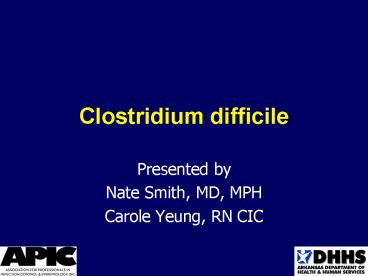Clostridium difficile PowerPoint PPT Presentation
1 / 34
Title: Clostridium difficile
1
Clostridium difficile
- Presented by
- Nate Smith, MD, MPH
- Carole Yeung, RN CIC
2
Outline
- Epidemiology
- Treatment
- Prevention
3
What is Clostridium difficile?
- Anaerobic spore-forming bacillus
- Present in the soil and environment
- Produces two toxins Toxins A and B
- Common cause of antibiotic associated diarrhea
(AAD). 15 25 all episodes of AAD - Health care settings are major reservoirs
- 20 40 hospital patients colonized
- 4 20 LTCF residents colonized
4
What are C. difficile-associated diseases (CDAD)
- Pseudomembranous colitis (PMC)
- Toxic megacolon
- Perforations of the colon
- Sepsis
- Death (rarely) but increasing!
5
CDAD-related deaths - Arkansas
2005 data incomplete
6
(No Transcript)
7
Symptoms of CDAD
- Watery diarrhea
- Fever
- Loss of appetite
- Abdominal pain
- Nausea and vomiting
- Severe cases increase WBC and/or creatinine
- Can occur up to 8 weeks after antimicrobial
therapy
8
Which patients are at increased risk for CDAD?
- Antibiotic exposure clindamycin, penicillins,
cephalosporins, floroquinolones - Gastrointestinal surgery
- Length of stay in healthcare settings
- A serious underlying illness
- Immunocompromising conditions
- Advanced age
9
C. difficile colonization
- Patient exhibits no clinical symptoms
- Patient tests positive for C. difficile organism
and/or its toxin - More common than CDAD
10
C. difficile disease (CDAD)
- Patient exhibits clinical symptoms
- Patient tests positive for C. difficile organism
and/or its toxin
11
Laboratory Tests for CDAD
- Stool culture
- Antigen detection
- Toxin testing
12
C. difficile Transmission
- C. difficile spores are shed in feces
- Any surface, device or material that becomes
contaminated with feces may serve as a reservoir - Transferred by hands of healthcare personnel
13
Treatment
- Discontinue antibiotics if feasible
- Metronidazole orally for 10 days
- Vancomycin orally
- Relapses are common
- Repeat testing NOT recommended
- NO antiperistalic agents
14
Infection Control Preventive Methods
- Use antibiotics judiciously
- Early diagnosis
- Contact precautions for patients with CDAD
- Hand hygiene
- Environmental cleaning and disinfection
15
Contact Precautions
- Private room or cohort
- Gloves
- Gowns
- Dedicated patient care equipment
16
Hand Hygiene
- Soap and water for at least 15 seconds
- Wet hands under running water
- Apply soap
- Good friction rub for 15 seconds
- Rinse hands
- Dry well with paper towel
17
(No Transcript)
18
(No Transcript)
19
(No Transcript)
20
(No Transcript)
21
(No Transcript)
22
(No Transcript)
23
(No Transcript)
24
(No Transcript)
25
(No Transcript)
26
(No Transcript)
27
(No Transcript)
28
(No Transcript)
29
(No Transcript)
30
Cleaning and Disinfection
- Clean/disinfect environmental surfaces and
reusable items - Hospital disinfectant
- 110 bleach
31
Discontinuing Precautions
- NO diarrhea. NO precautions!
- Repeat testing NOT recommended
32
Transfer of Patients
- Notify receiving facility if patient has a
history of C. difficile - Observe for recurrence
33
References
- SHEA Position Paper CDAD, ICHE 1995
- SHEA Position Paper C. difficile in LTCF for the
elderly, ICHE 2002
34
QUESTIONS?

